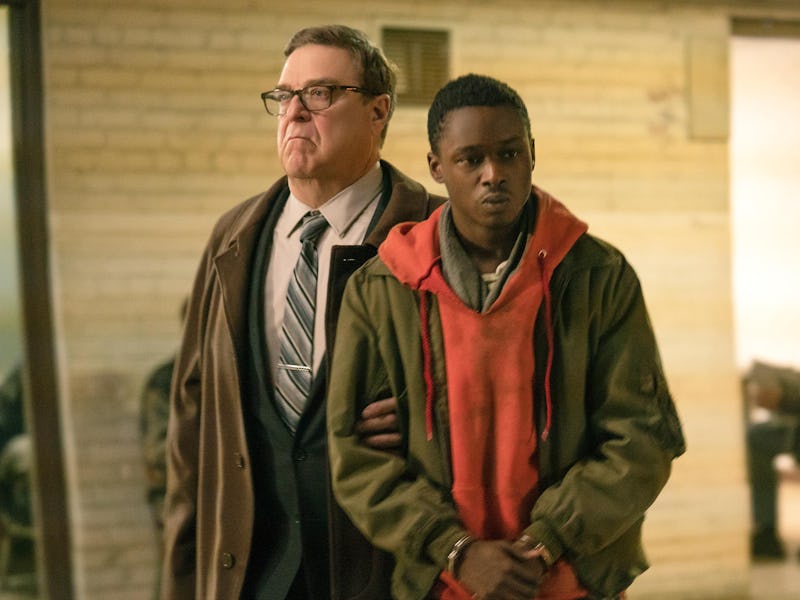'Captive State' Review: It's the "Overlords" Meme Made Into a Sci-Fi Movie
Rupert Wyatt's newest science-fiction movie tries to ask bold questions but ends up unremarkable.

If I pack this paragraph with film critic cliches, it might tell you everything about Captive State. It’s is a movie “derivative” of the dystopian drama, yet functional enough to not be a “Dumpster fire.” Nothing in the movie feels all that new, but what it does, it does well enough. Like a little brother using hand-me-downs, Captive State is aesthetically and spiritually too familiar. It has story beats that other movies have hit before, and better. It has a twist you’ll see coming a mile away if you’ve ever seen any other movie, ever.
Captive State’s miserable ensemble of characters, depressed world-building, and depleted color tones of gray and green feel well-worn, as other, better films have offered these elements before, and more memorably. There’s a great stretch in the middle, but it’s sandwiched between a bromidthere ic opening and a totally whack finale.
Out in theaters on March 16, Captive State is a sci-fi thriller about humans living under the rule of alien oppressors. Directed by Rupert Wyatt, whose comparable 2011 film, Rise of the Planet of the Apes still delivers chills, Captive State is the “I, for one, welcome our new overlords” meme made as a movie. It’s an aggressively mid-tier film that lacks the budget and mise-en-scène to match its director’s ambitions.
Nine years after a successful alien invasion of Earth (you can’t tell but it began in 2016), the alien “Legislators” — giant, buzzy aliens that look like wasps but have protruding spikes like sea urchins — maintain a grip over the world with strongholds in every major city.
Gabriel (Ashton Sanders), who was just a boy when the Legislators invaded, is one of the last members of a Chicago resistance group called Phoenix. Upon meeting a cop turned-district-chief named William Mulligan (John Goodman), the two form a rocky partnership marked by betrayal, secrets, and ulterior motives.
John Goodman and Ashton Sanders star in Rupert Wyatt's 'Captive State.'
Wyatt has said on occasions, including an interview with Inverse, that he started from a place of realism to explore man’s resistance to oppression. He didn’t want sprawling new worlds like those of Star Wars.
Instead, he wanted our real world to be upended by aliens. It sounds good on paper (especially the idea that the film, set in summertime, was shot in winter to emphasize the Legislators speeding up climate change).
In execution, Captive State is drab and uninteresting, its visuals failing to capture imagination or attention. It’s one dark abandoned house to one dimly lit parking lot to one industrial corridor to the next, all seen through the tired view of a handheld camera.
Having a bleak dystopia is no excuse to zap color or not do anything bold; Akira made Neo-Tokyo alive with a rich palette that told a million stories, while Children of Men made desaturated hues and interesting camera direction its best weapons.
Captive State comes armed with just the barest visual toolset; it tells a story. It just doesn’t tell a great one.
That story is also choppy in sections, which is unfortunate because the premise is rock solid. To call Captive State an “alien invasion” is a mistake; it isn’t War of the Worlds, Independence Day, or Battle: Los Angeles. You’ve seen humans fight and win. In Captive State, the aliens are here, and we lost.
It’s a great starting point with so much potential. And had Wyatt and co-writer Erica Beeney succeeded in their mission to show that there’s no difference between aliens and humans when it comes to wielding power, Captive State would have fulfilled its potential as a modern day Animal Farm.
But Captive State doesn’t follow through. Instead, we’re left with an unsatisfactory family drama of estranged brothers and conflict between allies who could have solved their trust issues with a single, five-minute talk.
There are moments when Captive State shines. While it isn’t perfect, a sublime sequence midway through the movie, in which rebels try to plant a bomb during a lame “Unity” ceremony put on by the Legislators, bleeds with tension and anxiety. It was probably the only real moment when Captive State actually put me in a captive state. And I surrendered.
'Captive State' isn't an alien invasion movie. It's a movie where the aliens are here, and they've already won.
It felt like a climax: A neat, pulse-pounding ending to an otherwise drab movie. But the film had the nerve to go on for another half hour, deflating the excitement. I got home a lot later from the screening than I would have liked.
Lacking cinematic firepower to distract us from its most horrendous flaws, Captive State occupies that ethereal space in between good and bad; a quantum dimension where the movie is fine-ish, but you’ll forget you even saw it hours later. When it’s on, you may enjoy its meatiest, juiciest stuff. But even its best parts never coalesce into a greater whole.
Captive State will be released in theaters on March 16.